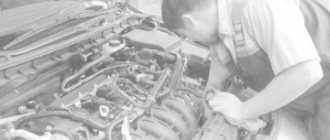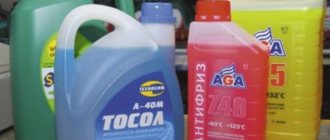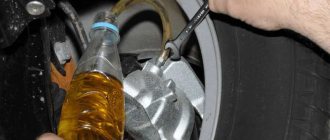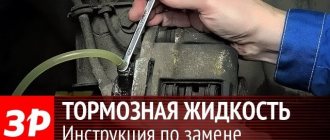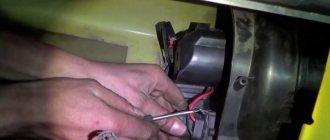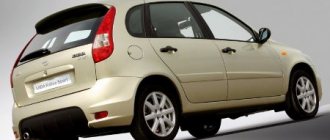To avoid engine overheating, the owner of a Lada Kalina is recommended to constantly monitor the level of antifreeze in the cooling circuit. For this purpose, there are special marks on the body of the expansion tank. The level should not be below the minimum and above the maximum. If there is a gradual decrease in the amount of antifreeze, then there is a high probability that a fluid leak will appear. In Lada Kalina, such hot spots can be areas connecting pipes to the radiator, tank or thermostat, as well as the pump gasket. In this article we will talk about how to drain antifreeze, as well as how to replace coolant in a car.
Which antifreeze to choose and what volume is needed
To completely change the cooling water in a 2nd generation Lada Kalina/Kalina car, you need 7.8 liters of antifreeze or antifreeze, depending on what you choose. Reddish Felix antifreeze is poured from the factory.
To completely replace the coolant (cooling water), we will need to purchase either one 10-liter canister, or two 5-liter containers.
Choosing antifreeze to replace
If reddish antifreeze was poured from the factory, then we recommend creating a replacement with reddish one.
- AGA 003Z (-40*) reddish 10l cost from 1000 rub.
- Professional Premium G-12 reddish 10 l cost from 700 rub.
- SINTEC LUX G-12 reddish 10l cost from 1000 rub.
- FELIX Carbox-40 (10 l) red price from 950 rub.
- NIAGARA G12 (10 l) red price from 800 rub.
- Arctic Circle G12 (10 l) red price from 700 rub.
All of the manufacturers mentioned above have proven themselves, so antifreeze from these manufacturers can be used for replacement.
What is needed for replacement
- Container for draining old antifreeze for 6-8 liters.
- 16mm head
- 13mm socket wrench for removing the starter on the 16 valve version of Kalina
It is better to create a replacement for a cool engine. Before replacement, you should release the pressure in the system by unscrewing the cap of the expansion tank. In order to freely access the drain plug, you need to remove the middle mud flap.
How much oil to pour into the Kalina gearbox
The factory's recommendation for filling volume for a gearbox states that 3.1 liters of gear oil is required for the gearbox. But according to many manuals of official publications, you can read that it is best to exceed this volume by some value.
Here it’s the other way around, it’s better that the level on the dipstick is slightly higher than the maximum, about 5 mm. This is necessary so that the fifth gear gears are better lubricated. Accordingly, this advice will extend the life of the transmission, or fifth speed in particular.
Instructions for replacing Coolant
On Kalinas with 8 and 16 valve engines, the coolant replacement is different. Old fluid can be drained from a radiator without any problems, but from a block on a 16- valve engine it is more difficult. You will have to unscrew the starter.
Replacing the coolant. Kalina
The time has come to change the coolant and the question arose whether to fill in Antifreeze or Tosol
, and how did you do it...
Read:
Features of replacing antifreeze on a Lada Kalina car
Replacing antifreeze
produced after 5 years.
Replacing antifreeze on an 8-valve Lada Kalina engine
So, we relieve the pressure in the system by unscrewing the cap of the expansion tank. Then we remove the motor protection to get to the drain plug.
We take a container with a volume of 6-8 liters. and place it under the drain hole located at the bottom right of the radiator. To make the pressure weaker, screw the expansion tank cap back.
Capacity of the windshield and rear window washer reservoir (hatchback or station wagon)
On the Kalina sedan car, the washer is only on the windshield, since on similar body types it is not needed at the rear. But on a station wagon or hatchback there is also a rear washer. But the capacity of the washer fluid reservoir is the same for any of the three body types and is 5 liters.
How to change the coolant (antifreeze or antifreeze) on a Lada Kalina
In order not to overheat the engine, you need to monitor the level of cooling water, making sure that you have antifreeze or antifreeze in it. Watch the water level in the expansion tank, and also check the pipes and their connections, as well as the pump, for signs of leakage. According to the factory regulations, a complete replacement of the filter is recommended once every 5 years or every 75 thousand kilometers.
Useful expert advice
If the expansion tank cap leaks and does not hold pressure, it should be replaced
- The lid will expand. tank 2108 2108-1311065 Automatic device price from 130 rub.
- The lid will expand. tank 2108 LUZAR LL 0108 price from 100 rub.
- The lid will expand. tank 2108 Chistopol 2108-1311065 price from 70 rub.
After replacing the antifreeze, check all pipes for signs of leakage. If necessary, replace the pipe clamps.
AVTOVAZ recommends replacing the fluid in the cooling system of the Lada Kalina every 75 thousand km of the vehicle or after five years, whichever comes first. Our illustrated step-by-step instructions will help you complete this procedure yourself.
LADA > Kalina
It is more convenient to replace the coolant when the car is installed on an inspection ditch or overpass.
We select consumable fluids for Kalina-2. Factory recommendations
A car manufacturing plant always recommends the use of fuels and lubricants of certain brands. As for gasoline, Kalina-2 owners are advised to refuel their cars with the following brand of fuel: “Premium Euro-95” (GOST R-51866). In fact, any gasoline with an octane rating of 95 will do, but the instructions state that the fuel must not contain metal additives (lead, iron, manganese). Such additives are the basis of anti-knock mixtures.
1449660639_2279_4_9a_01zh
We unscrew the plug and drain the coolant from the cylinder block.
We tighten the drain plugs of the radiator and cylinder block. The connection between the plug and the cylinder block uses a conical thread that does not require additional sealing. Tighten the drain plug of the cylinder block to a torque of 25–30 Nm. We pour the fluid recommended by the manufacturer into the engine cooling system through the expansion tank until it is full. Let's start the engine. With the engine running, vigorously compress all the hoses of the cooling system several times in turn - this will help the fluid fill the system and displace air from it. As the coolant level in the expansion tank drops, bring it to normal and screw on the tank cap. When the engine warms up, the outlet (lower) radiator hose should be cold for some time, and then quickly heat up, which will indicate the beginning of fluid circulation in a large circle. After waiting for the cooling system fan to turn on, stop the engine. After the engine has cooled, check the coolant level again and, if necessary, replenish the system.
Welcome! Thanks to this liquid, the car engine is cooled - the crankshaft, camshaft, cylinder block and other parts. Over time, the liquid becomes unusable and loses its properties: the additives expire, the car begins to overheat much more often, and this leads to rapid engine failure.
Note! You will need the following tools: a repair kit, socket wrenches, hex wrenches, wrenches and screwdrivers, a clean rag to remove traces of spilled liquid on the car engine.
Summary:
When to change the fluid?
There are several opinions: some complain about the replacement according to the regulations, others - that it can take longer, who to believe? Recently, many fakes have been produced for auto parts and components, and liquid is no exception. Therefore, when choosing a new liquid, be extremely careful. (The article will help you recognize a fake and buy a quality product: “Detailed information about Antifreeze and Antifreeze”)
The factory recommends changing the fluid every 75 thousand km or 3 years from the moment of filling. Keep in mind, these are deadlines. If possible, replace more often, do not let the additives wear out, because thanks to them the cooling system is protected from premature corrosion and other unfavorable things.
Note! So, we change the fluid either according to the factory’s recommendation or according to its appearance. To do this, unscrew the cap of the expansion tank (indicated by the arrow) and look inside. If the color of the liquid changes - it has acquired shades of rust, has become red-brown, then it is time to change it. An oil film on the surface is also an alarm bell for replacement.
How much oil to pour into Kalina engine
The manufacturer recommends pouring 3.5 liters of oil into the engine crankcase. It is this volume that is necessary for the normal operation and functioning of the car’s lubrication system. But if for some reason it is not possible to measure the volume, fill in engine oil until it is between the MIN and MAX marks on the dipstick.
Lack of lubrication in the engine can lead to oil starvation, which will have a very negative impact on the service life. If the level is too high, if it exceeds the maximum mark on the dipstick, it is possible to select some of it into the air filter bellows through the breather hose. From there it can get to the mass air flow sensor, which can lead to premature failure of this sensor.
How to replace coolant on a VAZ 1117-1119?
Note!
At engine operating temperature, the fluid heats up to 100 degrees - you can get burned. Sometimes you urgently need to cool the liquid - unscrew the cap of the expansion tank. Act carefully and smoothly, and completely remove the lid only if the hissing sound disappears, otherwise the air inside the tank will knock out the lid and the liquid will flow out in a column - everything around will get dirty, and you can get burned. It is best to work with a cold engine.
Remember! The liquid is highly toxic, pour it into a tightly closed container and throw it away not in a bucket, but in a landfill!
Merging
Drive the car into the inspection hole and ensure that it stands level. If this is not possible, park the car so that the front is higher than the rear.
All motor oils recommended for use
Engine oil is usually replaced along with a paper filter. This consumes 2900 ml of fluid (for versions with automatic transmission – 4100 ml). The intervals between replacements are indicated in the service book. Recommended materials for use:
| Brand | Viscosity SAE | Quality |
| Lukoil LUX | 15W40 | SL/CF (B5/D3) |
| Lukoil LUX semi-synthetics | 5W30, 5W40, 10W40 | SL/CF (B5/D3) |
| Lukoil LUX synthetic | 5W30, 5W40 | SN/CF (B6/D3) |
| Rosneft MAXIMUM (Angarsk, Novokuibyshevsk) | 5W40, 10W40 | SL/CF (B5/D3) |
| Rosneft PREMIUM (Angarsk) | 5W40 | SM/CF (B6/D3) |
| TNK MAGNUM SUPER | 5W30, 5W40, 10W40, 15W40, 15W50 | SL/SJ/CF (B5/D3) |
| Gazpromneft PREMIUM | 10W40 | SL/CF (B5/D3) |
| G-ENERGY S SYNTH, F SYNTH | 5W40, 10W40 | SL/CF (B5/D3) |
| G-ENERGY EXPERT L | 5W30, 5W40, 10W40 | SL/CF (B5/D3) |
| GT TURBO SM (Hanval INC) | 10W40 | SM (B5) |
| ESSO ULTRA | 10W40 | SL/SJ/CF (B5/D3) |
| MOBIL 1 ESP FORMULA | 5W30 | SN/SM/CF (B6/D3) |
| MOBIL 1 NEW LIFE, PEAK LIFE, SUPER 3000 X1 | 0W40, 5W40, 10W40, 5W50 | SN/SM/SL/SJ/CF (B6/D3) |
| MOBIL SUPER 2000 X1 | 0W40, 5W40, 10W40, 5W50 | SL/SJ/CF (B5/D3) |
| SHELL HELIX PLUS | 5W40, 10W40 | SL/CF (B5/D3) |
| SHELL HELIX ULTRA, HX7, HX8, PLUS EXTRA | 5W40, 10W40 | SM/CF (B6/D3) |
| ZIC A PLUS | 5W30, 10W30, 10W40 | SL (B5) |
To narrow the range of choices, be guided by the climatic conditions in which the car will be used. It is recommended to determine the viscosity class based on air temperature:
| lower limit | Viscosity grade | Upper limit |
| –35 and below | 0W40 | +30 |
| –30 | 5W30 | +25 |
| –30 | 5W40 | +35 |
| –25 | 10W30 | +25 |
| –25 | 10W40 | +35 |
| –20 | 15W40 | +45 |
| –20 | 20W50 | 45 and above |
It is recommended to change the oil at a service station (service station). , however, the owner himself can add liquid to the tank.
Adding oil to the expansion tank
The oil level is controlled as follows: when the engine is turned off, unscrew the diagnostic dipstick located near the cylinder head cover between the third and second cylinders. A secondary check is carried out no earlier than after 3–5 minutes. after topping up.
Remember that motor oils of different brands cannot be mixed. The same applies to materials made on different bases (synthetic/semi-synthetic). Be careful when choosing.
The factory usually fills it with semi-synthetic material with a viscosity of 5W30 produced by Rosneft OJSC. Check the information by opening the service book.
DS555555555
If the engine is hot, you need to let it cool and then relieve excess pressure in the cooling system by unscrewing the expansion tank cap.
To access the drain holes from below, you must remove the middle mudguard of the engine compartment. How to perform this operation can be found in the article “Changing the oil and oil filter of Lada Kalina”.
We place a wide container with a volume of at least 6 liters under the drain hole made in the lower part of the right radiator tank. To reduce the intensity of liquid drainage at the initial moment, the cap of the expansion tank should be tightly screwed on.
Why does it flow
If the level of the recently filled substance began to decrease sharply, then this action may be the consequence of some breakdowns. Now we will look at them.
- The pipe is cracking; in this case, you need to check the clamps and tighten them tighter.
- Mechanical damage in the radiator, the situation can be corrected by welding or gluing the necessary parts.
- The pump has broken down, or rather the pump has worn out; in this situation the pump will have to be replaced.
- The most difficult failure to fix is when the element leaks from under the head. With this breakdown, you will most likely have to contact a service center, where they will disassemble the engine and repair the head.
- The leak occurs directly into the interior of the car, try to look under the carpet on the driver or passenger side, if it is wet or damp, it means that the element is leaking here.
Source
How to change coolant
Before changing the coolant, you need to figure out where the procedure is located, how many liters need to be filled, where the indicator should be located and how to determine the level. You need to find the expansion tank. It is located in the engine compartment, on the mudguard on the left, in the area of the bracket and is held on by clamps.
Then purchase 10 liters of antifreeze or antifreeze. Which is better, judge for yourself. Antifreeze is slightly inferior in functionality to antifreeze; moreover, antifreeze is mostly sold ready-made, which makes it much easier to use. Choose only high-quality and reliable products. Before the replacement begins, you should pay attention to the smell, the temperature sensor and the fluid level. All this indicates an immediate “replacement” procedure.
The normal level should fluctuate somewhere around 3-4 mm above, if this is not the case, then you should replace the coolant on Kalina.
To get started, you will need to acquire some tools:
Now with all this baggage you can begin the first part of the work. Let the engine cool down first.
- Place the machine on level ground.
- Open the hood and remove the engine splash guard.
- Remove the negative terminal from the battery.
- We take out the plug from the tank.
Unscrew the cap from the tank
- Place the drain container and unscrew the drain plug.
- Remove the ignition module and bracket.
- Remove the plug from the radiator. And now you need to drain all the antifreeze.
VAZ (lada) kalina 2nd generation sport hatchback 5-door. specifications
| Length, mm | 4040 | 4040 | 4040 |
| Width, mm | 1700 | 1700 | 1700 |
| Height, mm | 1500 | 1500 | 1500 |
| Base, mm | 2470 | 2470 | 2470 |
| Front wheel track, mm | 1430 | 1430 | 1430 |
| Rear wheel track, mm | 1410 | 1410 | 1410 |
| Luggage compartment volume, dm3 | 400 | 400 | 400 |
| Weight in running order, kg | 1080 | 1080 | 1080 |
| Gross vehicle weight, kg | 1555 | 1555 | 1555 |
| Permissible total weight of a towed trailer with brakes, kg | 900 | 900 | 900 |
| Permissible total weight of the lettered trailer without brakes, kg | 450 | 450 | 450 |
| Wheel formula/drive wheels | 4x2/front | ||
| Car layout diagram | front-wheel drive, front engine, transverse | ||
| Body type/number of doors | sedan/4 | ||
| engine's type | gasoline, four-stroke | ||
| Supply system | Electronically controlled distributed injection | ||
| Engine displacement, cm3 | 1596 | 1596 | 1390 |
| Maximum power, kW/rpm | 59,5/5200 | 59,5/5200 | 65,5/5250 |
| Maximum torque, Nm at rpm | 120 / 2500-2900 | 120 / 2500-2900 | 127 / 4200-4800 |
| Fuel | unleaded gasoline AI-95 (min) | ||
| Fuel consumption by driving cycle, l/100 km | 7,8 | 7,8 | 7,0 |
| Maximum speed, km/h | 160 | 160 | 165 |
| Transmission | With manual control | ||
| Number of gears | 5 forward, 1 reverse | ||
| Main gear ratio | 3,7 | 3,7 | 3,7 |
| Steering | with electromechanical amplifier, rack and pinion steering mechanism | ||
| Tires | 175/70R13 80T,82T,H 5J x 13 | 175/65R14 82H 5J x 14 | 185/60R14 82H 5.5J x 14 |
| Fuel tank capacity | 50 | 50 | 50 |
New Lada: Lada Granta Sport 2015 - Wheel and tire sizes, PCD, wheel offset and other specifications - Wheel Size.RU
| 1.6 MT (118 hp) | — | — | — | — | — | 2021 | 2021 |
Refill tanks for Lada Kalina 8 valves
Quite often, many novice owners are interested in questions such as: “how much gasoline will fit in the tank” or “how much oil to pour into the engine.”
Since there are many such questions and every day at least 1000 people are looking for such information, it was decided to post expanded information on the main refueling volumes of the Lada Kalina on the blog. Let's start with perhaps the most common questions, and we will list the less popular ones in order of priority.
Types of oils
At the end of the article, we will name three types of motor oils, and then determine the best of them for the Lada Kalina engine:
- Synthetic oil is the most environmentally friendly oil, containing an optimal set of additives that are not capable of harming the engine. This consumable material has good non-stick and antioxidant properties, effectively cools the motor components, and thereby prevents them from overheating. In addition, this is the most fluid and liquid oil, adapted to frost. It will never thicken, and this oil ensures easy and quick engine starting in any weather. The only negative is the high cost
- Mineral oil is cheap, and this is its main advantage. Another feature is its excessive thickness. Because of this, mineral oil thickens quickly and is therefore unsuitable for low temperatures.
- Semi-synthetic is a good inexpensive oil consisting of 70% mineral and 30% synthetic oils. Definitely better than the first, but in many ways inferior to the second product. And yet, this is a worthy alternative to expensive synthetics.
We can conclude that the best option for Lada Kalina in terms of price and quality will be semi-synthetic oil. But if funds allow, then definitely synthetics.
Main filling volumes
Quite often, many novice owners are interested in questions such as: how much gasoline will fit into the tank or how much oil to pour into the engine. Because there are many similar questions and every day at least 1000 people look for such information, it was decided to post extended information on the main refueling volumes of the Lada Kalina on the blog.
Let's start, perhaps, with frequently encountered questions, and we will list the least popular of them in order of priority.
Procedure for checking the Lada cooling system
1. Check the coolant level in the expansion tank; it should be between the “MIN” and “MAX” marks. If antifreeze has to be added periodically, then the system is not sealed (we check the integrity of: hoses, radiator drain holes, cylinder block, sensor installation locations, expansion tank housing, pump and its connections, engine and heater radiators).
2. Check the thermostat. We warm up the engine to 85-92C and check the lower radiator hose leading from the radiator (in diagram No. 10), if it is cold, it means the coolant is circulating only in a small circle, the thermostat is faulty and should be replaced.
3. Check the circulation of antifreeze in the cooling system. Open the cap of the expansion tank and monitor the flow of antifreeze into the tank. Attention, the cooling system is under pressure, and the antifreeze in the system may be hot; open the expansion tank cap very carefully. Poor circulation of antifreeze indicates a malfunction of the water pump (pump), or the cooling system is clogged (needs to be cleaned).
If the engine radiator fan does not turn on, then you should check: the fuse, additional resistance, relay, integrity of electrical circuits, temperature sensor and fan motor (more details).
Let us remind you that the formation of air in the cooling system may be due to a malfunction of the expansion tank cap. See also the solution to the problem of air in the cooling system.
Source
